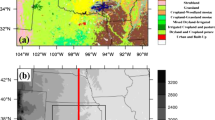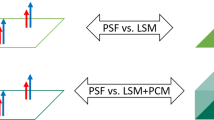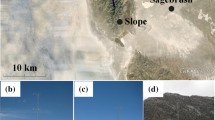Abstract
This paper reports analysis of eddy-covariance data collected during the WFIP2 field campaign in the complex-terrain of the US Pacific Northwest. A 31-day period representative of the region’s dry season was used to address the following questions: (1) To what extent does the Constant-Flux Layer (CFL) assumption hold? (2) What is the spatial variability of turbulent and momentum fluxes over km scales? and (3) How skilful are the surface-layer parameterizations of mesoscale models? These questions are directly relevant to subgrid parameterization studies of mesoscale models. Results show that the efficacy of the CFL concept and the spatial variability of turbulent and momentum fluxes are dependent on: (i) the turbulent parameter being analysed, (ii) the measurement’s location, (iii) the atmospheric stability regime (determined by the flow and vertical stratification), and (iv) the magnitude of the flux. Finally, the skill of the physics formulation of an often-used surface-layer parameterization scheme available in the Weather Research and Forecasting (WRF) model was also evaluated. Meteorological conditions associated with the highest and the lowest errors were identified. A metric to quantify (time-dependent) flow heterogeneity is proposed, which appears to be a good candidate to predict the skill of idealized surface-layer parameterization schemes in complex terrain.















Similar content being viewed by others
Data availability
The datasets analysed during the current study are available in the WFP2 repository of the Atmosphere to Electrons Data archive of the U.S. Department of Energy and is publicly available to download at https://a2e.energy.gov/projects/wfip2
References
Bodini N, Lundquist JK, Krishnamurthy R, Pekour M, Berg LK, Choukulkar A (2019) Spatial and temporal variability of turbulence dissipation rate in complex terrain. Atmos Chem Phys 19(7):4367–4382
Carvalho L, Duine GJ, Jones C et al (2020) The sundowner winds experiment (SWEX) pilot study: understanding downslope windstorms in the Santa Ynez Mountains, Santa Barbara, California. Mon Weather Rev 148:1519–1539. https://doi.org/10.1175/MWR-D-19-0207.1
Chow FK, Schär C, Ban N, Lundquist KA, Schlemmer L, Shi X (2019) Crossing multiple gray zones in the transition from mesoscale to microscale simulation over complex terrain. Atmosphere 10(5):274
Chung U, Seo HH, Hwang KH et al (2006) Minimum temperature mapping over complex terrain by estimating cold air accumulation potential. Agric for Meteorol 137:15–24. https://doi.org/10.1016/j.agrformet.2005.12.011
Eder F, Schmidt M, Damian T et al (2015) Mesoscale eddies affect near-surface turbulent exchange: evidence from lidar and tower measurements. J Appl Meteorol Climatol 54:189–206. https://doi.org/10.1175/JAMC-D-14-0140.1
Fernando HJS (2010) Fluid dynamics of urban atmospheres in complex terrain. Annu Rev Fluid Mech 42:365–389. https://doi.org/10.1146/annurev-fluid-121108-145459
Fernando HJS, Pardyjak ER, Di Sabatino S et al (2015) Unraveling the intricacies of mountain weather. Bull Am Meteorol Soc. https://doi.org/10.1175/BAMS-D-13-00131.1
Fernando HJS, Mann J, Palma JMLM et al (2019) The perdigao peering into microscale details of mountain winds. Bull Am Meteorol Soc. https://doi.org/10.1175/BAMS-D-17-0227.1
Garratt J (1994) The atmospheric boundary layer. Earth Sci Rev 37(1–2):89–134. https://doi.org/10.1007/3-211-38078-7_4
Giovannini L, Ferrero E, Karl T et al (2020) Atmospheric pollutant dispersion over complex terrain: challenges and needs for improving air quality measurements and modeling. Atmosphere (basel) 11:1–32. https://doi.org/10.3390/atmos11060646
Grachev AA, Fairall CW, Blomquist BW, Fernando HJS, Leo LS, Otárola-Bustos SF, Wilczak JM, McCaffrey KL (2020) On the surface energy balance closure at different temporal scales. Agric Forest Meteorol. https://doi.org/10.1016/j.agrformet.2019.107823
Grachev AA, Fairall CW, Blomquist BW, Fernando HJ, Leo LS, Otárola-Bustos SF, McCaffrey KL (2022) A hybrid bulk algorithm to predict turbulent fluxes over dry and wet bare soils. J Appl Meteorol Climatol 61(4):393–414
Grell GA, Dudhia J, Stauffer DR (1995) A Description of the Fifth- Generation Penn State/NCAR Mesoscale Model (MM5) NCAR Technical Note, NCAR/TN-398+STR, Boulder, CO., 138 pp
Gultepe I, Sharman R, Williams PD et al (2019) A review of high impact weather for aviation meteorology. Pure Appl Geophys 176:1869–1921. https://doi.org/10.1007/s00024-019-02168-6
Haupt SE, Kosovic B, Shaw W et al (2019) On bridging a modeling scale gap: mesoscale to microscale coupling for wind energy. Bull Am Meteorol Soc 100:2533–2549. https://doi.org/10.1175/BAMS-D-18-0033.1
Hong S-Y, Dudhia J (2012) Next-generation numerical weather prediction: bridging parameterization, explicit clouds, and large eddies. Bull Am Meteorol Soc 93:ES6–ES9. https://doi.org/10.1175/2011bams3224.1
Jiménez PA, Dudhia J, González-Rouco JF et al (2012a) A revised scheme for the WRF surface layer formulation. Mon Weather Rev 140:898–918. https://doi.org/10.1175/MWR-D-11-00056.1
Kadivar M, Tormey D, McGranaghan G (2021) A review on turbulent flow over rough surfaces: fundamentals and theories. Int J Thermofluids 10:100077
Kaimal JC, Businger JA (1970) Case studies of a convective plume and a dust devil. J Appl Meteorol Climatol 9(4):612–620
Klipp CL, Mahrt L (2004) Flux–gradient relationship, self-correlation and intermittency in the stable boundary layer. Quart J R Meteorol Soc J Atmosph Sci Appl Meteorol Phys Oceanogr 130(601):2087–2103
Li D, Katul GG, Liu H (2018) Intrinsic constraints on asymmetric turbulent transport of scalars within the constant flux layer of the lower atmosphere. Geophys Res Lett 45(4):2022–2030
Liang J, Guo Q, Zhang Z et al (2020) Influence of complex terrain on near-surface turbulence structures over loess plateau. Atmosphere Basel. https://doi.org/10.3390/atmos11090930
Luchetti NT, Friedrich K, Rodell CE, Lundquist JK (2020) Characterizing thunderstorm gust fronts near complex terrain. Mon Weather Rev 148:3267–3286. https://doi.org/10.1175/MWR-D-19-0316.1
Maronga B, Raasch S (2013) Large-eddy simulations of surface heterogeneity effects on the convective boundary layer during the LITFASS-2003 experiment. Boundary-Layer Meteorol 146:17–44. https://doi.org/10.1007/s10546-012-9748-z
Maronga B, Knigge C, Raasch S (2020) An improved surface boundary condition for large-eddy simulations Based on Monin-Obukhov similarity theory: evaluation and consequences for grid convergence in neutral and stable conditions. Boundary Layer Meteorol 174:297–325. https://doi.org/10.1007/s10546-019-00485w
Martins CA, Moraes OLL, Acevedo OC, Degrazia GA (2009) Turbulence intensity parameters over a very complex terrain. Boundary-Layer Meteorol 133:35–45. https://doi.org/10.1007/s10546-009-9413-3
Monin AS, Obukhov AM (1954) Basic laws of turbulent mixing in the surface layer of the atmosphere. Contrib Geophys Inst Acad Sci USSR 151(163):e187
Moraes OL, Acevedo OC, Degrazia GA, Anfossi D, da Silva R, Anabor V (2005) Surface layer turbulence parameters over a complex terrain. Atmos Environ 39(17):3103–3112
Muñoz-Esparza D, Cañadillas B, Neumann T, Van Beeck J (2012) Turbulent fluxes, stability and shear in the offshore environment: mesoscale modelling and field observations at FINO1. J Renew Sustain Energy. https://doi.org/10.1063/1.4769201
Nadeau DF, Pardyjak ER, Higgins CW, Parlange MB (2013) Similarity scaling over a steep alpine slope. Boundary Layer Meteorol 147:401–419. https://doi.org/10.1007/s10546-012-9787-5
Nakanishi M, Niino H (2009) Development of an improved turbulence closure model for the atmospheric boundary layer. J Meteorol Soc Japan 87:895–912. https://doi.org/10.2151/jmsj.87.895
Obukhov A (1946) Turbulence in thermally inhomogeneous atmosphere. Trudy Inst Teor Geofiz Akad Nauk SSSR 1:95–115
Panofsky A. Determination of stress from wind. Q J R Meteorol Soc, (1962)
Panofsky HA, Dutton JA (1984) Atmospheric turbulence—models and methods for engineering applications. Wiley, New York, p 397
Pope SB, Pope SB (2000) Turbulent flows. Cambridge University Press
Rai RK, Berg LK, Pekour M et al (2017) Spatiotemporal variability of turbulence kinetic energy budgets in the convective boundary layer over both simple and complex terrain. J Appl Meteorol Climatol 56:3285–3302. https://doi.org/10.1175/JAMC-D-17-0124.1
Sati AP, Mohan M (2021) Impact of urban sprawls on thunderstorm episodes: Assessment using WRF model over central-national capital region of India. Urban Clim 37:100869. https://doi.org/10.1016/j.uclim.2021.100869
Sfyri E, Rotach MW, Stiperski I et al (2018) Scalar-flux similarity in the layer near the surface over mountainous terrain. Boundary Layer Meteorol 169:11–46. https://doi.org/10.1007/s10546-018-0365-3
Skamarock WC, Klemp JB, Dudhia J, Gill DO, Barker DM, Duda MG, Huang X-Y, Wang W, Powers JG. A Description of the Advanced Research WRF Version 3, National Center for Atmospheric Research Technical Note NCAR, Boulder (2008) http://www.mmm.ucar.edu/wrf/users/docs/arw_v3.pdf
Stoll R, Gibbs JA, Salesky ST et al (2020) Large-eddy simulation of the atmospheric boundary layer. Boundary Layer Meteorol 177:541–581. https://doi.org/10.1007/s10546-020-00556-3
Stull RB (1988) An introduction to boundary layer meteorology, vol 13. Springer Science and Business Media
Tampieri F, Maurizi A, Viola A (2009) An investigation on temperature variance scaling in the atmospheric surface layer. Boundary Layer Meteorol 132(1):31–42
Walmsley JL, Taylor PA (1996) Boundary-layer flow over topography: impacts of the Askervein study. Boundary Layer Meteor 78(34):291–320. https://doi.org/10.1007/BF00120939
Wilczak JM, Oncley SP, Stage SA (2001) Sonic anemometer tilt correction algorithms. Boundary Layer Meteorol 99(1):127–150
Wilczak JM et al (2019) The second wind forecast improvement project (WFIP2): observational field campaign. Bull Am Meteor Soc. https://doi.org/10.1175/BAMS-D-18-0035.1
Wouters H, de Ridder K, van Lipzig NPM (2012) Comprehensive parametrization of surface-layer transfer coefficients for use in atmospheric numerical models. Boundary Layer Meteorol 145:539–550. https://doi.org/10.1007/s10546-012-9744-3
Wyngaard JC (2011) The atmospheric surface layer. Turbul Atmos. https://doi.org/10.1017/cbo9780511840524.011
Zilitinkevich SS (1970) Dynamics of the atmospheric boundary layer. Gidrometeoizdat, Leningrad, p 290
Zilitinkevich SS, Chalikov DV (1968) The laws of resistance and of heat and moisture exchange in the interaction between the atmosphere and an underlying surface. Izv Acad Sci USSR Atmos Ocean Phys 4:765–772
Zilitinkevich SS, Fedorovich EE, Shabalova MV (1992) Numerical model of a non-steady atmospheric planetary boundary layer, based on similarity theory. Boundary Layer Meteorol 59(4):387–411. https://doi.org/10.1007/BF02215460
Zilitinkevich SS, Grachev AA, Fairall CW (2001) Scaling reasoning and field data on the sea-surface roughness lengths for scalars. J Atmos Sci 58(3):320–325
Zilitinkevich SS, Hunt JCR, Esau IN, Grachev AA, Lalas DP, Akylas E, Tombrou M, Fairall CW, Fernando HJS, Baklanov AA, Joffre SM (2006) The influence of large convective eddies on the surface layer turbulence. Quart J Roy Met Soc 132(618A):1423–1456. https://doi.org/10.1256/qj.05.79
Zilitinkevich SS, Elperin T, Kleeorin N, Rogachevskii I, Esau I (2013) A hierarchy of energy—and flux-budget (FEB) turbulence closure models for stably-stratified geophysical flows. Boundary Layer Meteorol 146(3):341–373. https://doi.org/10.1007/s10546-012-9768-8
Acknowledgements
University of Notre Dame contribution to WFIP2 project was funded by the grant DOE-WFIFP2-SUB-001. The work appearing in this paper was supported by the US National Science Foundation Award AGS-1921554. The authors would like to thank the reviewers and editor for their valuable feedback during the peer-review process, which helped improve the overall quality of the manuscript. Finally, we would like to express our gratitude to Paolo Gianni from the University of Notre Dame, who provided thoughtful and valuable feedback that contributed to this manuscript.
Author information
Authors and Affiliations
Corresponding author
Additional information
Publisher's Note
Springer Nature remains neutral with regard to jurisdictional claims in published maps and institutional affiliations.
Appendix
Appendix
See Figs
16,
Wind speed and wind direction profiles from the combined measurements from the tower and the Sodar at site T1 that were used to estimate the roughness length value. This profile was aggregated for multiple periods with Near-Neutral (NN) conditions and the measured standard deviation is indicated by the black horizontal lines
17,
18,
An example of the methodology proposed by Panofsky (1962) to determine roughness length. The methodology was applied to the velocity profiles measured at site T1 (as shown in Fig. A. 2)
19,
20,
Topography of instrumented region (grayscale) and tower sites with annotated terrain elevation. The percentual differences between local and spatially averaged temperature fluxes at z = 10 m are shown for all sites. a Corresponds to UN periods between 12:00 and 15:00 PST for the observational period. b Same as before, but for Stable periods between 00:00 and 03:00 PST
21,
Topography of instrumented region (grayscale) and tower sites with annotated terrain elevation. Local values of friction velocity (\({u}^{*}\)) at z = 10 m are shown for all sites. a Corresponds to UN periods between 12:00 and 15:00 PST for the observational period. b Same as before, but for Stable periods between 00:00 and 03:00 PST
Topography of instrumented region (grayscale) and tower sites with annotated terrain elevation. Local values of temperature fluxes (\( \overline{{wT}} \)) at z = 10 m are shown for all sites. a Corresponds to UN periods between 12:00 and 15:00 PST for the observational period. b Same as before, but for Stable periods between 00:00 and 03:00 PST
Rights and permissions
Springer Nature or its licensor (e.g. a society or other partner) holds exclusive rights to this article under a publishing agreement with the author(s) or other rightsholder(s); author self-archiving of the accepted manuscript version of this article is solely governed by the terms of such publishing agreement and applicable law.
About this article
Cite this article
Otarola Bustos, S.F., Fernando, H.J.S., Wilczak, J.M. et al. Subgrid Variability of Atmospheric Surface-Layer Parameters in Complex Terrain. Boundary-Layer Meteorol 187, 229–265 (2023). https://doi.org/10.1007/s10546-023-00797-y
Received:
Accepted:
Published:
Issue Date:
DOI: https://doi.org/10.1007/s10546-023-00797-y












